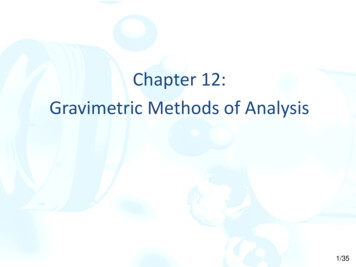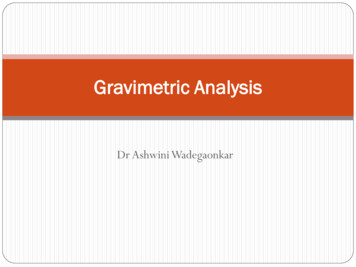
Transcription
Chapter 12:Gravimetric Methods of Analysis1/35
Gravimetric methods: The quantitative methods that are basedon determining the mass of a pure compound to which theanalyte is chemically related. Precipitation gravimetry: The analyte is separated from asolution of the sample as a precipitate and is converted to acompound of known composition that can be weighed. Volatilization gravimetry: The analyte is separated fromother constituents of a sample by converting it to a gas ofknown chemical composition that can be weighed. Electrogravimetry: The analyte is separated by deposition onan electrode by an electrical current.2/35
12A Precipitation gravimetry The analyte is converted to a sparingly soluble precipitate that isthen filtered, washed free of impurities and converted to aproduct of known composition by suitable heat treatment andweighed.Ex. for determining the [Ca2 ] in water: 22NH 3(aq) H 2 C2 O 4(aq) 2NH 4(aq) C2 O 4(aq)Ca 2 C2 O 2-4(aq) CaC2 O 4(s)filtered, dried, ignited CaC2 O 4(s) CaO(s) CO(g) CO 2(g)After cooling, the precipitate is weighed and the mass isdetermined.3/35
12A-1 Properties of Precipitates and Precipitating Reagents A gravimetric precipitating agent should react specifically or at least selectivelywith the analyte and give precipitates that is:1.Enough particle size for retaining on filter paper2.High purity (free of contaminants)3.Low solubility that no significant loss of the analyte occurs during filtrationand washing*4.Unreactive with air (stable)5.Known stoichimetric composition after it is dried or, if necessary, ignitedSpecific reagents: react only with a single chemical species.Selective reagents: react with a limited number of species.4/35
12A-2 Particle Size and Filterability of Precipitates Characteristics of Ion, colloid and particle The particle size of solids formed by precipitation varies enormously. At oneextreme are colloidal suspensions, whose tiny particles are invisible to the nakedeye (10-7 to 10-4 cm in diameter). Colloidal particles show no tendency to settlefrom solution and are difficult to filter. At the other extreme are particles with dimensions on the order of tenths of amillimeter or greater. The temporary dispersion of such particles in the liquidphase is called a crystalline suspension. The particles of a crystalline suspensiontend to settle spontaneously and are easilyfiltered.NameDiameterCharacteristicsIon 10-8 cm (A )DissolvedColloid10-7 10-4 cm (nm-µm)SuspendedCrystalline 10-4cm (µm)Settled from solution (filterable) Precipitates consisting of large particles are generally desirable for gravimetricwork because these particles are easy to filter and wash free of impurities.5/35
Factors That Determine the Particle Size of Precipitates Precipitate formation has been studied for many years, but the mechanismof the process is still not fully understood. What is certain, however, is that theparticle size of a precipitate is influenced by* precipitate solubility,* temperature,* reactant concentrations, and the* rate at which reactants are mixed.The net effect of these variables can be accounted for, at least qualitatively, byassuming that the particle size is related to a single property of the systemcalled relative supersaturation, whereQ:S:the concentration of the solute at any instantthe concentration solute at equilibriumQ -SRSS SVon Weimarn equation, 19256/35
Relative supersaturation (RSS)- A supersaturated solution is an unstablesolution that contains a higher soluteconcentration than a saturated solution. As excesssolute precipitates with time, supersaturationdecreases to zero.Q -SRSS S-Generally, precipitation reactions are slow so that, even whena precipitating reagent is added drop by drop to a solution ofan analyte, some supersaturation is likely.- Experimental evidence indicates that the particle size of aprecipitate varies inversely with the average relativesupersaturation during the time when the reagent is beingintroduced. Thus, when (Q - S)/S is large, the precipitate tendsto be colloidal, and when (Q - S)/S is small, a crystalline solid ismore likely.RSSProcessResultLargeNucleation dominateSmaller particles ( colloidal)SmallParticle growth dominateLarger Particle (Crystalline)7/35
Mechanism of Precipitate Formation Nucleation and Particle growth Nucleation: The initial formation process in which a minimum number ofatoms, ions, or molecules join together to give a stable solid. Often, these nuclei form on the surface of suspended solid contaminants,such as dust particles Particle growth: The subsequent growth after nucleation. If nucleation predominates, a precipitate containing a largenumber of small particles results, and if growth predominates, a smaller number of larger particlesis produced.RSSProcessResultLargeNucleation dominateSmaller particles ( colloidal)SmallParticle growth dominateLarger Particle (Crystalline)8/35
Experimental Control of Particle Size(the lower RSS value the larger particles) Increase S: Heating to increase solubility pH adjustment (If the solubility of the precipitatedepends on pH) Adding complexing agent Decrease Q: Using dilute precipitating solution Adding precipitating agent slowly and stirring Using homogeneous precipitation technique9/35
12A-3 Colloidal Precipitates Individual colloidal particles are so small that they are not retained by ordinaryfilters. Moreover, Brownian motion prevents their settling out of solution underthe influence of gravity. Fortunately, however, we can coagulate, or agglomerate, the individualparticles of most colloids to give a filterable, amorphous mass that will settleout of solution.(When liquid starts to thicken and become solid, it coagulates)( agglomeration: a large group of many different things collected or brought together)Coagulation of Colloids Coagulation can be hastened by heating, by stirring, and by adding an electrolyte to themedium. To understand the effectiveness of these measures, we need to look into whycolloidal suspensions are stable and do not coagulate spontaneously. Colloidal suspensions are stable because all of the particles of the colloid are eitherpositively or negatively charged and thus repel one another. The charge results fromcations or anions that are bound to the surface of the particles. We can show thatcolloidal particles are charged by placing them between charged plates where some ofthe particles migrate toward one electrode while others move toward the electrode ofthe opposite charge. The process by which ions are retained on the surface of a solid isknown as adsorption.10/35
– an electric double layer: Attached directly to the solid surface isthe primary adsorption layer, whichconsists mainly of adsorbed silver ions.Surrounding the charged particle is alayer of solution, called the counter-ionlayer, which contains sufficient excessof negative ions (principally nitrate) tojust balance the charge on the surfaceof the particle. These layers constitute an electricdouble layer that imparts stability to thecolloidal suspension. As colloidalparticles approach one another, thisdouble layer exerts an electrostaticrepulsive force that prevents particlesfrom colliding and adhering.Figure 12.1 A colloidal silver chloride (AgCl) suspended in a solution of excess AgNO3Adsorption: A process in which a substance (gas, liquid, or solid) is held on the surface of a solid.Absorption: A process in which a substance within the pores of a solid.Figure 12-1 p284
The effective charge on two silver chloride particlesIn Fig.12(a), The upper curverepresents a particle in a solution thatcontains a reasonably large excess ofsilver nitrate, and the lower curvedepicts a particle in a solution that has amuch lower silver nitrate content.The effective charge can be thoughtas a measure of the repulsive forcethat the particle exerts on likeparticles in the solution.Note that the effective charge falls offrapidly as the distance from the surfaceincreases, and it approaches zero at thepoints d1 or d2.Figure 12-2 Effect of AgNO3 and electrolyte concentrationon the thickness of double layer surrounding a colloidalAgCl particle in a solution containing excess AgNO3.12/35
Coagulation of ColloidsFigure 12-3 The electrical doublelayer of a colloid consists of a layerof charge adsorbed on the surface ofthe particle (the primary adsorptionlayer) and a layer of opposite charge(the counter-ion layer) in the solutionsurrounding the particle. Increasingthe electrolyte concentration has theeffect of decreasing the volume of thecounter-ion layer, thereby increasingthe chances for coagulation.* The upper portion of Figure 12-3 depicts two silverchloride particles and their counter- ion layers asthey approach each other in the concentrated silvernitrate just considered. Note that the effectivecharge on the particles prevents them fromapproaching one another more closely than about2d1—a distance that is too great for coagulation tooccur.* As shown in the lower part of Figure 12-3, in themore dilute silver nitrate solution, the two particlescan approach within 2d2 of one another.Ultimately, as the concentration of silver nitrate isfurther decreased, the distance between particlesbecomes small enough for the forces ofagglomeration to take effectAnd a coagulated precipitateto appear.A coagulated colloid13/35
Coagulation of a colloidal suspension can often be brought about by a short period ofheating, particularly if accompanied by stirring. Heating decreases the number of adsorbed ions and thus the thickness, of thedouble layer. The particles may also gain enough kinetic energy at the highertemperature to overcome the barrier to close approach imposed by the doublelayer.Figure 12-2 Effect of AgNO3 and electrolyte concentrationon the thickness of double layer surrounding a colloidal AgClparticle in a solution containing excess AgNO3. An even more effective way tocoagulate a colloid is to increase theelectrolyte concentration of thesolution. If we add a suitable ioniccompound to a colloidal suspension,the concentration of counter-ionsincreases in the vicinity of eachparticle. As a result, the volume ofsolution that contains sufficientcounter-ions to balance the chargeof the primary adsorption layerdecreases. The net effect of addingan electrolyte is thus a shrinkage ofthe counter-ion layer, as shown inFigure 12-2b. The particles can thenapproach one another more closelyand agglomerate.14/35
Peptization of ColloidsPeptization: The process by which a coagulated colloid reverts to its originaldispersed colloidal suspension state.(When a coagulated colloid is washed, some of the electrolyte responsiblefor its coagulation is removed, therefore, the repulsive forces as well as theoriginal colloidal state are reestablished.)Solution: Use of Volatile electrolyte as washing solution, e.g., HNO3, NH4NO3, toavoid peptization.Practical Treatment of Colloidal PrecipitatesColloids are best precipitated from hot, stirred solutions containing sufficient electrolyteto ensure coagulation. The filterability of a coagulated colloid often improves if it isallowed to stand for an hour or more in contact with the hot solution from whichit was formed. During this process, which is known as digestion, weakly bound waterappears to be lost from the precipitate. The result is a denser mass that is easier tofilter.Digestion is a process in which a precipitate is heated in the solution fromwhich it was formed (the mother liquor) and allowed to stand in contact with thesolution. Mother liquor is the solution from which a precipitate was formed.15/35
12A-4 Crystalline Precipitates Crystalline precipitates are generally more easily filtered and purified than arecoagulated colloids. Particle size of crystalline solids can often be improved significantly by minimizing Q (by using dilute solutions, and adding the precipitating reagentslowly, with good mixing) or maximizing S (precipitating from hot solution or by adjusting the pH), or both. Digestion improves the purity and filterability of both colloidal and crystallineprecipitates. The improvement in filterability undoubtedly results from the dissolution andrecrystallization that occur continuously and at an enhanced rate at elevatedtemperatures. Recrystallization apparently results in bridging between adjacent particles, aprocess that yields larger and more easily filtered crystalline aggregates. Thisview is supported by the observation that little improvement in filteringcharacteristics occurs if the mixture is stirred during digestion.16/35
12A-5 CoprecipitationCoprecipitation: A process in which normally soluble compounds are carried out ofsolution by a precipitate. It may resulted in impurities within the desiredprecipitates. Coprecipitated impurities may cause either negative or positive errors. There are four types of coprecipitation: surface adsorption, mixed-crystal formation, occlusion, and mechanical entrapment.17/35
Surface Adsorption: The impurity is chemically or physically adsorbed onto the surface of precipitates Adsorption is the major source of contamination in coagulated colloids but of nosignificance in crystalline precipitates. Minimizing Adsorbed Impurities on Colloids Washing a coagulated colloid with a solution containing a volatile electrolyte Digestion: during this process, water is expelled from the solid to give a densermass that has a smaller specific surface area for adsorption. Reprecipitation: In this process, the filtered solid is redissolved and reprecipitated.The solution containing the redissolved precipitate has a significantly lowercontaminant concentration than the original, and even less adsorption occursduring the second precipitation.18/35
Mixed-Crystal Formation: A type of coprecipitation in which a contaminant ion replaces an ionin the lattice of a crystal.Ex. SrSO4 in BaSO4MgKPO4 in MgNH4PO4MnS in CdS Mixed-crystal formation may occurin both colloidal and crystalline precipitates Problem solving: Change to another more selective precipitating agent Reprecipitation19/35
Occlusion: A type of co-precipitation in which a compound (foreign ions in the counter-ion layer )is physically trapped within a precipitate during rapid precipitate formation. Problem solving: DigestionDigestion: The process which has a waiting timeto achieve desired outcome.(The solubility–precipitation is in a dynamicequilibrium, digestion ensures the occludedmaterial is eventually exposed to the supernatantsolution.) Mechanical Entrapment: A type of co-precipitation in which coprecipitated physically trap a pocket ofsolution within a precipitate during rapid precipitate formation. Problem solving: DigestionMixed-crystal formation may occur in both colloidal andcrystalline precipitates, but occlusion and mechanicalentrapment are confined to crystalline precipitates.20/35
12A-6 Precipitation from Homogeneous Solution Homogeneous precipitation is a process in which a precipitate is formed by slowgeneration of a precipitating reagent homogeneously throughout a solution. Solids formed by homogeneous precipitation are generally purer and larger in sizeExample 1: Urea, for generating OH– as precipitant (Al(III), Fe(III))CO(NH2)2(aq) 3 H2O(l) CO2(g) 2 NH4 (aq) 2 OH–(aq)* Generation rate can be controlled by temperatureExample 2: For generating SO42– as precipitantNH2SO3H(aq) 2H2O(l) NH4 (aq) H3O (aq) SO42–(aq)* Generation rate can be controlled by pH21/35
12A-7 Drying and Ignition of Precipitates A gravimetric precipitate is heated until its mass becomes constant. Heating removes the solvent and any volatile species carried down with the ppt. Some precipitates are also ignited to decompose the solid and form a compoundof known composition. This new compound is often called the weighing form. The temperature required to dehydrate a precipitatecompletely may be as low as 100 C or as high as 1000 C Moisture is completely removed from silver chloride attemperatures higher than 110 C, but dehydration ofaluminum oxide is not complete until a temperaturegreater than 1000 C is achieved. The thermal curve for calcium oxalate is considerablymore complex than the others Recording thermal decomposition curves is calledthermogravimetric analysis, and the mass versustemperature curves are termed thermograms.Figure 12-6 Effect of temperatureon precipitate mass.22/35
12B Calculation of results from gravimetric data23/35
24/35
25/35
Gravimetric factor: A gravimetric factor is an algebraicexpression that converts grams of a compound into grams ofa single element. It is the ratio of the formula weight (FW) ofthe substance being sought to that of the substance weighed.Example 1. Fe is sought, Fe2O3 is weighed:Example 2. Fe3O4 is sought, Fe2O3 is weighed:26/35
27/35
28/35
12C Applications of gravimetric methods12C -1 Inorganic Precipitating Agents* These reagentstypically formslightly solublesalts or hydrousoxides with theanalyte. As youcan see from themany entries foreach reagent, fewinorganic reagentsare selective.29/35
12C-2 Reducing Agents(convert an analyte to its elemental form form for weighing)30/35
12C-3 Organic Precipitating Agents Some organic reagents react with metal ions then produce insoluble coordination cmpds. Reagents that form coordination compounds of this type are called chelating agents, andtheir products are called chelates. Those metal chelates are relatively nonpolar and have low solubilities in water. Usually, these compounds possess low densities and are often intensely colored. Becausethey are not wetted by water, coordination compounds are easily freed of moisture at lowtemperatures.31/35
Magnesium complex with 8-hydroxyquinoline.32/35
Nickel dimethylglyoxime isspectacular in appearance.As shown in colorplate 7, it has a beautifulvivid red color.33/35
sodium tetraphenylborate.34/35
12C-4 Organic Functional Group Analysis Several reagents react selectively with certain organic functional groups and thus canbe used for the determination of most compounds containing these groups. Many of the reactions shown can also be used for volumetric and spectrophotometricdeterminations.35/35
12C-5 Volatilization Gravimetry The two most common: determining water and carbon dioxide. Water is quantitatively distilled from many materials by heating. In direct determination water vapor is collected on any of several soliddesiccants, and its mass is determined from the mass gain of the desiccant. The indirect method in which the amount of water is determined by the lossof mass of the sample during heating is less satisfactory because it must beassumed that water is the only component that is volatilized. determination of the sodium hydrogen carbonate content of antacid tabletsFigure 12-8 Apparatus for determining the sodium hydrogen carbonate content of antacid tabletsby a gravimetric volatilization procedure.NaHCO3(aq) H2SO4(aq) CO2(g) H2O(l) NaHSO4(aq36/35
12C-5 Volatilization Gravimetry Sulfides and sulfites can also be determined by volatilization.Hydrogen sulfide or sulfur dioxide evolved from the sample aftertreatment with acid is collected in a suitable absorbent. Finally, the classical method for the determination of carbonand hydrogen in organic compounds is a gravimetricvolatilization procedure in which the combustion products(H2O and CO2) are collected selectively on weighed absorbents. The increase in mass serves as the analytical variable.37/35
Homework (Due 06/03/2018)Chapter 12, Questions and Problems12-1, 12-2, 12-4, 12-5, 12-7, 12-9-(a,c,e), 12-10, 12-12, 12-18, 12-2012-22, 12-25, 12-29, 12-30, 12-33End of Chapter 1238/35
compound to a colloidal suspension, the concentration of counter-ions increases in the vicinity of each particle. As a result, the volume of solution that contains sufficient counter-ions to balance the charge of the primary adsorption layer decreases. The net effect of adding an electrolyte is thus a shrinkage of the counter-ion layer, as shown in










